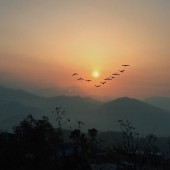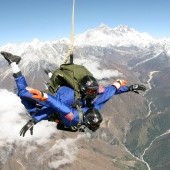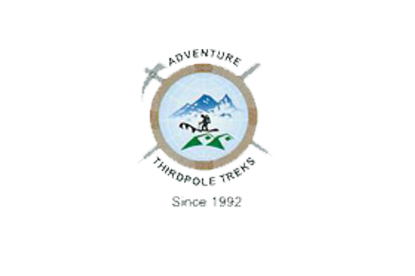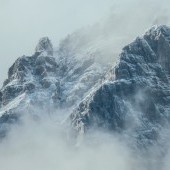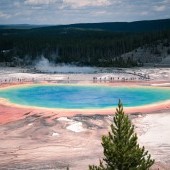5 Best Summer Treks in Nepal
Nepal offers some of the most breathtaking trekking and unique experiences in the world, and summer is a great time to explore its diverse landscapes.
While Nepal offers trekking all season, here are the top five summer treks. This list is made from the different feedback and ratings from the people who have traveled to this country extensively.
Everest Base Camp
Trekking to the base camp of the world's highest mountain is an adventure of a lifetime. While summer brings monsoon rains, the Everest region remains relatively dry, making it a suitable time for this iconic trek. The lush greenery and blooming rhododendrons in the lower slopes add to the beauty.
The Everest Base Camp trek typically spans 12 to 14 days, consisting of a mix of challenging ascents and descents through the stunning Himalayan landscape. Starting in Lukla after a flight from Kathmandu, the journey progresses through picturesque villages like Namche Bazaar and Tengboche, allowing for acclimatization breaks.
The trek is considered to be a moderate trek.
The trek culminates in breathtaking views of Mount Everest before retracing steps back to Lukla for the return flight to Kathmandu. Though moderately challenging, the trek offers a once-in-a-lifetime experience for adventurers seeking the world's tallest peak.
Here are the mountains that you can see during the Everest base camp trek:
Mount Everest: The highest mountain in the world, towering at an impressive 8,848 meters (29,029 feet) above sea level.Lhotse: This formidable peak stands as the fourth-highest mountain globally, reaching a height of 8,516 meters (27,940 feet).
Nuptse: with its rugged terrain, Nuptse reaches an elevation of 7,861 meters (25,791 feet). It's located adjacent to Mount Everest.
Ama Dablam: Known for its striking beauty, Ama Dablam soars to an elevation of 6,812 meters (22,349 feet).
Cho Oyu: The sixth-highest mountain in the world, Cho Oyu, reaches an impressive height of 8,188 meters (26,864 feet).
Pumori: Pumori stands tall at an elevation of 7,161 meters (23,494 feet) and is known for its distinctive features.
Island Peak (Imja Tse): This trekking peak rises to 6,189 meters (20,305 feet) and offers stunning views of the surrounding mountains.
Taboche: With its pointed summit, Taboche reaches an elevation of 6,495 meters (21,309 feet) and is often photographed from various angles along the trek.
Thamserku: Thamserku's elevation is 6,623 meters (21,729 feet), and it features a long ridgeline. It stands prominently near the village of Namche Bazaar.
Kongde Ri: Kongde Ri offers panoramic views and stands at an elevation of 6,187 meters (20,298 feet) in the Khumbu region.
Animals, Plants, and Birds Life Found in EBC Trekking Route
Besides mountains, this trek will provide you with a wide range of animal, plant, and bird life as follows.
Animals
Yaks: These sturdy and shaggy bovine creatures are a common sight at higher altitudes, used for transporting goods. They are well adapted to the rugged terrain and harsh climate.
Himalayan Tahr: These robust herbivores with curved horns are often spotted on rocky slopes, especially in the higher elevations.
Red Panda: Although rare to spot due to their elusive nature, the red panda inhabits the forests in the region. Known for their striking rust-colored fur, they are a protected species in Nepal.
Snow Leopard: An extremely elusive and rarely seen predator, snow leopards inhabit the remote, higher reaches of the Himalayas, including the Everest region.
Pika: These small, rabbit-like mammals inhabit rocky habitats at higher elevations and are known for their distinctive "cheeping" calls.
Marmots: These burrowing mammals are often seen sunbathing near their burrows in the alpine meadows. They whistle to communicate with one another.
Plants
Rhododendrons: The lower sections of the trek feature lush forests of rhododendrons, which bloom in vibrant shades of red, pink, and white during the spring season.
Juniper and Pine Trees: As you ascend, the landscape transitions to forests of juniper and pine trees, which are adapted to the harsh alpine conditions.
Moss and Lichens: At higher elevations, the landscape becomes more barren, with mosses and lichens covering rocks and surfaces.
Alpine Flowers: Above the tree line, alpine meadows come alive with various wildflowers, including gentians, primulas, and the iconic edelweiss.
Birch Trees: In certain parts of the trek, you'll encounter birch trees with their distinctive white bark, providing a stark contrast to the rocky terrain
Birds
Himalayan Griffon: These massive vultures can often be seen circling overhead, especially near higher elevations.
Golden Eagle: With their impressive wingspans, golden eagles are among the prominent raptors in the region.
Himalayan Snowcock: This bird is known for its striking appearance and is often found in alpine areas, particularly above the tree line.
Red-Billed Chough: These large, black birds with red bills and legs are commonly seen in the Everest region and are known for their acrobatic flight.
White-Throated Dipper: Often found near fast-flowing streams, these small birds are known for their distinctive habit of bobbing up and down.
Himalayan Monal: This vibrantly colored bird is the national bird of Nepal. It's known for its striking plumage and can sometimes be seen in the lower forested areas
Annapurna Circuit Trek
The Annapurna Circuit is a classic trek that offers a wide range of scenery, from subtropical forests to high alpine terrain. During summer, the lower regions are green and vibrant, and you can experience the local culture in villages like Manang and Pisang.
The Annapurna Circuit trek typically spans around 18 to 21 days, offering a diverse and rewarding experience in the Annapurna region of Nepal. It is a moderate trek but a long one.
Starting in Besisahar and ending in Nayapul, the journey takes trekkers through lush forests, terraced fields, charming villages, and High Mountain passes
The circuit includes acclimatization stops in places like Manang and Thorong Phedi, crucial for adapting to the increasing altitude.
The highlight of the trek is crossing the challenging Thorong La Pass (5,416m/17,769ft), which demands physical endurance and altitude adjustment.
The trail also provides opportunities to explore the unique culture and traditions of the local communities. Overall, the Annapurna Circuit trek is a longer but equally rewarding adventure, showcasing the natural beauty and cultural richness of the region.
Here are the list of mountains that can be observed during the Annapurna Circuit Trek:
Machapuchare (Fishtail Mountain): Although not as tall as some of the others, Machapuchare's distinctive fishtail shape is iconic. It stands at 6,993 meters (22,943 feet).
Annapurna II: This mountain reaches a height of 7,937 meters (26,040 feet) and is the second-highest peak in the Annapurna range.
Annapurna III: At 7,555 meters (24,787 feet), Annapurna III is the third-highest mountain in the Annapurna range.
Annapurna IV: Annapurna IV has an elevation of 7,525 meters (24,688 feet) and is another notable peak in the region.
Gangapurna: Gangapurna is a subsidiary peak of Annapurna I and stands at an elevation of 7,455 meters (24,457 feet).
Tilicho Peak: Located near the stunning Tilicho Lake, Tilicho Peak reaches an elevation of 7,134 meters (23,406 feet).
Hiunchuli: Hiunchuli is another peak in the Annapurna massif, with a height of 6,441 meters (21,132 feet).
Lamjung Himal: Lamjung Himal is visible on the earlier stages of the trek and has an elevation of 6,983 meters (22,917 feet).
Annapurna I: The namesake of the region, Annapurna I, is the main attraction. It stands as the tenth highest mountain globally, reaching an impressive elevation of 8,091 meters (26,545 feet).
Dhaulagiri I: Dhaulagiri I is the seventh-highest mountain in the world, towering at a height of 8,167 meters (26,795 feet).
Animals, Plants, and Birds Found in ABC Circuit
Like EBC, Annapurna Trekking Circuit is also rich in other faunas and floras.
Animals
Snow Leopard: Although rare and elusive, the Annapurna region is home to the elusive snow leopard, a highly endangered species.
Himalayan Tahr: These large, goat-like animals are commonly spotted in the higher altitudes of the region.
Red Panda: Another elusive creature, the red panda inhabits the dense forests of the Annapurna Conservation Area.
Musk Deer: These small, solitary deer are known for their musk glands and are found in the region's forests.
Langur Monkeys: Gray langur monkeys are commonly seen swinging through the trees along the trekking trails.
Plants
Rhododendrons: The Annapurna region boasts numerous species of rhododendrons, and during the spring, the hillsides are ablaze with their vibrant red, pink, and white blossoms.
Blue Poppies: These rare and striking blue flowers can be found at higher elevations, adding to the area's floral diversity.
Juniper Trees: Junipers are common in lower elevations, and their aromatic wood is used for incense.
Pine Forests: Pine trees cover many parts of the trekking route, offering shade and a pleasant fragrance.
Alpine Meadows: As you ascend to higher altitudes, you'll encounter alpine meadows carpeted with a variety of wildflowers.
Birds
Himalayan Monal: This colorful bird is not only one of the most iconic birds in the region but also represents Nepal as the national bird.
Himalayan Griffon Vulture: These massive birds of prey can often be seen soaring in the sky.
Golden Eagle: These majestic eagles are occasionally spotted in the Annapurna region.
Snow Partridge: A well-camouflaged bird that inhabits the higher elevations.
Himalayan Wagtail: Often seen near rivers and streams, wagtails are known for their distinctive bobbing tail movement.
Langtang Valley Trek
Langtang Valley is a beautiful trekking destination that is less crowded than some of the more popular routes. In summer, the valley is lush with wildflowers, and you can explore Langtang National Park, home to diverse wildlife and the pristine Gosainkunda Lake.
The Langtang Valley trek in Nepal spans approximately 65 to 75 kilometers (40 to 47 miles) and typically takes 7 to 10 days to complete. It's considered of moderate difficulty, making it suitable for both novice and experienced trekkers.
The trek involves varying terrain, from lush forests to rocky paths, with some steep sections. Altitude acclimatization is crucial due to altitudes of around 3,870 meters (12,700 feet) at Kyanjin Gompa.
While physically demanding, proper preparation, including conditioning, acclimatization, and gear, can make the Langtang Valley trek a rewarding experience, offering breathtaking mountain views and a chance to immerse in the local Tamang culture.
Animals, Plants, and Birds Found in Langtang Valley Trek
The Langtang Valley trek in Nepal is renowned for its stunning natural beauty and biodiversity. Here are some of the animals, plants, and birds you might encounter while trekking in the Langtang Valley.
Animals
Red Panda: The Langtang National Park is one of the few places in the world where you can spot the elusive red panda. These adorable creatures are known for their distinctive reddish-brown fur.
Himalayan Tahr: This large herbivorous mammal with curved horns is often seen grazing on the steep slopes of the Langtang region.
Snow Leopard: Although extremely rare to spot due to their elusive nature, the Langtang Valley is one of the habitats for these elusive and endangered big cats.
Langur Monkeys: Langur monkeys are commonly seen in the forests of the Langtang Valley. They are known for their long tails and distinctive black faces.
Himalayan Black Bear: Another elusive creature, the Himalayan black bear, inhabits the higher reaches of the Langtang region.
Plants
Rhododendrons: The Langtang Valley is famous for its vibrant rhododendron forests. These colorful flowers bloom in spring, adding a burst of color to the landscape.
Juniper Trees: The high-altitude areas of the Langtang Valley are home to juniper trees, which are adapted to the harsh mountain environment.
Bamboo Forests: Bamboo groves can be found in the lower regions of the valley and provide habitat for various wildlife.
Medicinal Herbs: The Langtang region is rich in medicinal herbs, and local communities have been using them for generations for various remedies.
Birds
Himalayan Monal: This strikingly colorful pheasant is often spotted in the Langtang region, especially in the forests.
Impeyan Pheasant (Danphe): The national bird of Nepal, the Impeyan pheasant, is known for its beautiful plumage and can be seen in higher altitudes.
Himalayan Griffon: These large vultures are a common sight, soaring above the valley.
Yellow-billed Blue Magpie: These colorful birds with striking blue and black plumage and a yellow beak are often seen in the Langtang forests.
Himalayan Buzzard: A variety of raptors, including the Himalayan buzzard, can be seen circling overhead in the Langtang Valley.
Manaslu Base Camp Trek
The Manaslu Base Camp Trek is located in the Gorkha District of Nepal, in the western part of the country. The trek encircles Mount Manaslu, the eighth-highest peak in the world, and takes you through the Manaslu Conservation Area.
The Manaslu Base Camp Trek is moderately to highly difficult due to its high-altitude sections, challenging terrain, and long duration. With altitudes exceeding 5,000 meters and the Larke Pass reaching 5,160 meters, altitude sickness is a concern, necessitating careful acclimatization.
The trek covers a substantial distance through remote, rugged terrain, including steep ascents, descents, and river crossings. Crossing Larke Pass, often icy and snowy, is particularly challenging. Basic teahouse accommodations and unpredictable weather add to the difficulty.
Obtaining permits can be complex, requiring assistance, and it's crucial to prepare with physical training, proper gear, and the option of a local guide or porter, making this trek suitable for experienced, well-prepared trekkers seeking a rewarding adventure.
Animal, Plants, and Flowers in Manaslu Base Camp
The Manaslu Base Camp area in Nepal boasts a diverse range of wildlife, birds, and flora. Here's a glimpse of what you might encounter during your trek.
Animals
Himalayan Tahr: These sure-footed herbivores, resembling wild goats, are commonly spotted in the Manaslu region, often grazing on steep mountain slopes.
Snow Leopard: Though exceedingly rare to see due to their elusive nature, the Manaslu Conservation Area is one of their habitats, offering a slim chance of encountering this magnificent but elusive big cat.
Himalayan Goral: These small, agile ungulates are often seen darting among the rocky terrain of the region.
Red Panda: In the dense forests of the area, you may come across the elusive red panda, known for its reddish-brown fur and distinctive appearance.
Langur Monkeys: These charismatic primates, with long tails and black faces, are frequently seen in the lush forests along the trekking trail.
Birds
Himalayan Monal: With its vibrant and iridescent plumage, the Himalayan Monal is a striking and iconic bird species of the region.
Himalayan Griffin Vulture: These large scavenger birds can often be seen circling high in the sky, keeping the landscape clean.
Blood Pheasant: Named for its crimson plumage, the blood pheasant is another eye-catching bird species native to the area.
White-throated Dipper: These small, plump birds are known for their distinctive habit of bobbing up and down while perched on rocks in fast-flowing mountain streams.
Rufous-vented Tit: This colorful bird with its distinctive plumage and calls adds to the avian diversity of the Manaslu region.
Plants
Rhododendrons: The Manaslu area, especially during the spring season, is a riot of colors thanks to the blooming rhododendrons, with shades ranging from deep red to vibrant pink.
Juniper Trees: In the higher elevations, you'll find hardy juniper trees, well adapted to the harsh mountain environment.
Bamboo Groves: Lower regions of the trekking trail are often adorned with bamboo forests, adding to the scenic beauty.
Alpine Flora: As you ascend higher into the alpine zone, you'll encounter a variety of alpine flowers, mosses, and lichens, adapted to the extreme conditions of the high Himalayas.
Upper Mustang Trek
The Upper Mustang Trek in Nepal offers an extraordinary adventure through the hidden kingdom of Mustang, a culturally rich and geographically stunning region.
This trek necessitates special permits due to its restricted status, granting access to a world of traditional Tibetan-style villages, ancient monasteries, and striking arid landscapes. The walled city of Lo Manthang, with its medieval charm and historic sites, is a major highlight, all while providing awe-inspiring views of the Annapurna and Dhaulagiri mountain ranges.
Interactions with the friendly locals and immersion in their unique way of life make this trek a captivating cultural and natural experience.
While it can be physically demanding due to high altitudes and rugged terrain, the Upper Mustang Trek promises an unforgettable journey into a remote and untouched part of Nepal.
The Upper Mustang trek presents a moderately challenging adventure in Nepal, characterized by its high-altitude terrain, remote location, and unique cultural experiences.
Ascending to elevations exceeding 13,000 feet (4,000 meters) with the Lo Manthang region itself situated above 12,000 feet (3,660 meters), altitude acclimatization is important to reduce the risk of altitude sickness.
During the Upper Mustang trek in Nepal, trekkers can enjoy stunning views of several prominent mountain ranges. Some of the notable mountains and peaks that can be seen along the trek include:
Dhaulagiri Range: The Dhaulagiri Range, with its majestic Dhaulagiri I (the seventh-highest mountain in the world), is a prominent feature of the trek. This range lies to the west of the Upper Mustang region and provides a breathtaking backdrop.
Annapurna Range: The Annapurna Range, including peaks like Annapurna I and Annapurna II, is visible to the south of the Upper Mustang region. These snow-capped peaks add to the scenic beauty of the trek.
Nilgiri: Nilgiri, which means "Blue Mountain," is another impressive peak that trekkers can see. It is part of the Nilgiri Himal, and its distinctive appearance makes it stand out in the landscape.
Tilicho Peak: While not as well-known as some other peaks, Tilicho Peak is still a notable mountain that can be spotted during the trek. It is part of the Annapurna Massif and adds to the mountainous panorama.
Lhakpa Ri: To the north, on the Tibetan plateau, trekkers can catch glimpses of Lhakpa Ri, a notable peak near Mount Everest. Its distinctive pyramid shape makes it easily recognizable.
The Upper Mustang region in Nepal is a unique and remote area with a distinctive landscape and wildlife. While trekking in the Upper Mustang, you can encounter various animals, plants, and birds. Here are some of the notable ones:
Animals
Yak: Yaks are commonly seen in Upper Mustang, often used as pack animals to transport goods in this rugged terrain. They are large, shaggy-haired mammals well-adapted to high-altitude environments.
Horses and Mules: These are also used for transportation in the region and can be frequently spotted along the trekking routes.
Blue Sheep (Bharal): These agile mountain sheep are found on the rocky cliffs and hillsides of Upper Mustang. They are known for their bluish-gray fur and distinctive curved horns.
Snow Leopard: Although quite rare to spot, the elusive snow leopard inhabits the Upper Mustang region. These big cats are masters of camouflage and are rarely seen by trekkers.
Plants
Barberry: The region is home to various plant species, including barberry bushes, which have bright red berries and are commonly found in the Mustang landscape.
Juniper: Juniper trees are scattered across the region and add to the unique vegetation of Upper Mustang.
Wildflowers: During the spring and summer months, you can find various wildflowers in bloom, adding color to the arid landscape. Species like edelweiss and blue poppies are not uncommon.
Birds
Himalayan Griffon: This large vulture is often seen soaring in the skies of Upper Mustang. They are scavengers and play an important role in the ecosystem.
Snow Partridge: This ground-dwelling bird is well adapted to the harsh high-altitude environment and is known for its distinctive markings.
Himalayan Monal: With its vibrant and iridescent plumage, the Himalayan Monal is a striking bird that can be found in the forests and hills of Upper Mustang.
Tibetan Snowcock: Another bird adapted to high altitudes, the Tibetan Snowcock is known for its distinctive calls and can sometimes be spotted in rocky terrain.
Raptors: Various birds of prey, including eagles and hawks, can be seen hunting in the skies above Upper Mustang.
So, These are the top five summer trekking destinations and the things you can enjoy while traveling to this destination. There are more than five destinations, but these got the most ratings.
